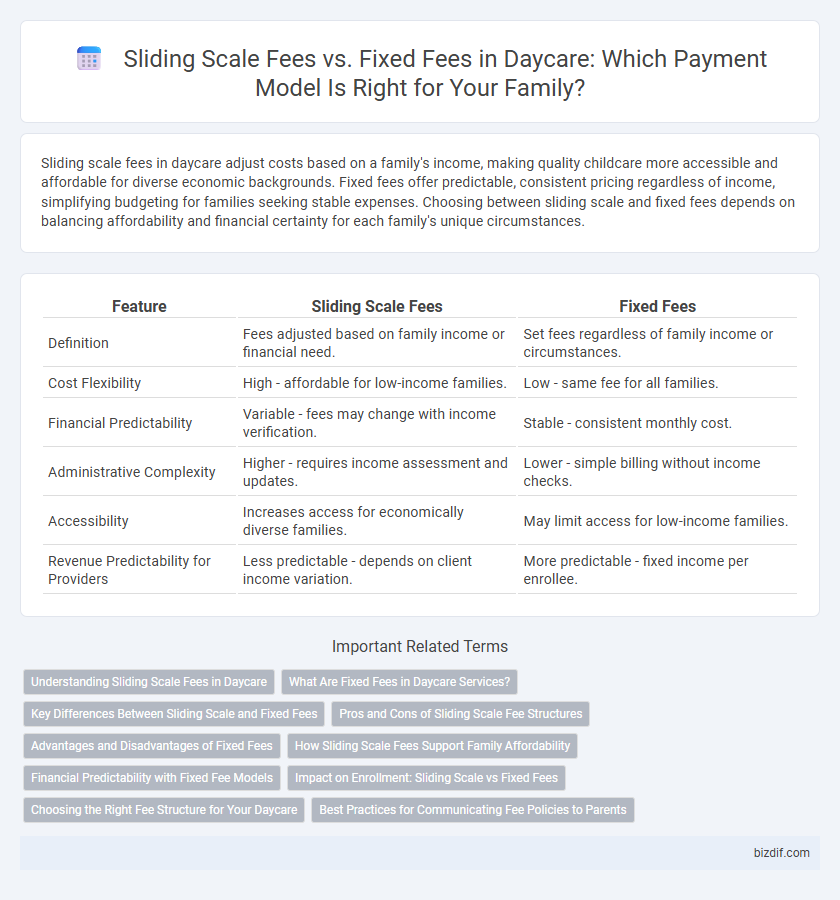Sliding scale fees in daycare adjust costs based on a family's income, making quality childcare more accessible and affordable for diverse economic backgrounds. Fixed fees offer predictable, consistent pricing regardless of income, simplifying budgeting for families seeking stable expenses. Choosing between sliding scale and fixed fees depends on balancing affordability and financial certainty for each family's unique circumstances.
Table of Comparison
| Feature | Sliding Scale Fees | Fixed Fees |
|---|---|---|
| Definition | Fees adjusted based on family income or financial need. | Set fees regardless of family income or circumstances. |
| Cost Flexibility | High - affordable for low-income families. | Low - same fee for all families. |
| Financial Predictability | Variable - fees may change with income verification. | Stable - consistent monthly cost. |
| Administrative Complexity | Higher - requires income assessment and updates. | Lower - simple billing without income checks. |
| Accessibility | Increases access for economically diverse families. | May limit access for low-income families. |
| Revenue Predictability for Providers | Less predictable - depends on client income variation. | More predictable - fixed income per enrollee. |
Understanding Sliding Scale Fees in Daycare
Sliding scale fees in daycare adjust costs based on a family's income, allowing more affordable access for low- to moderate-income households. This system promotes financial equity by tailoring childcare expenses to individual financial situations, unlike fixed fees that charge a uniform rate regardless of income. Understanding sliding scale fees helps parents budget childcare more effectively while ensuring quality care remains accessible.
What Are Fixed Fees in Daycare Services?
Fixed fees in daycare services refer to a set, consistent payment amount charged regardless of the number of hours a child attends or the family's income level. These fees simplify budgeting for parents by providing predictable monthly costs, typically covering full-day or half-day care options. Fixed fee structures are common in centers aiming for straightforward pricing without income-based adjustments or variable rates.
Key Differences Between Sliding Scale and Fixed Fees
Sliding scale fees adjust based on a family's income, offering more affordable daycare options for low-income households, while fixed fees remain constant regardless of financial status. Sliding scale models promote accessibility and inclusivity, supporting families with varying economic backgrounds. Fixed fees provide predictability and straightforward budgeting but may limit affordability for some families.
Pros and Cons of Sliding Scale Fee Structures
Sliding scale fee structures in daycare offer affordability by adjusting costs based on family income, promoting inclusivity and access for diverse economic backgrounds. However, managing sliding scale fees can complicate enrollment processes and create administrative burdens for providers. Fixed fees provide predictable revenue and simpler management but may exclude low-income families due to affordability challenges.
Advantages and Disadvantages of Fixed Fees
Fixed fees in daycare provide predictable monthly costs, making budgeting straightforward for families and reducing administrative complexity for providers. However, they may not accommodate varying attendance patterns, potentially leading to overpayment during low-use periods or financial strain for families unable to afford the set rate. This rigidity can limit access for low-income families, unlike sliding scale fees that adjust costs based on income and usage.
How Sliding Scale Fees Support Family Affordability
Sliding scale fees adjust childcare costs based on a family's income, making daycare more accessible and affordable for lower-income households. This flexible fee structure ensures that families pay rates proportionate to their financial capacity, reducing economic barriers to quality early childhood education. By contrast, fixed fees can strain family budgets, limiting childcare options for those with limited resources.
Financial Predictability with Fixed Fee Models
Fixed fee models in daycare provide families with financial predictability by offering consistent monthly rates regardless of attendance variations. Unlike sliding scale fees, which fluctuate based on income or hours used, fixed fees simplify budgeting for parents and ensure steady cash flow for daycare providers. This stability helps both parties manage expenses without unexpected financial surprises.
Impact on Enrollment: Sliding Scale vs Fixed Fees
Sliding scale fees increase enrollment by accommodating families with varying income levels, making daycare more accessible to a broader demographic. Fixed fees offer predictable revenue but may limit enrollment to families who can afford set rates, potentially excluding lower-income households. Offering sliding scale fees can enhance community inclusivity and boost overall attendance in daycare programs.
Choosing the Right Fee Structure for Your Daycare
Choosing the right fee structure for your daycare involves evaluating sliding scale fees, which offer flexible pricing based on family income, versus fixed fees that provide consistent, predictable revenue. Sliding scale fees enhance accessibility and appeal to a broader range of families but require careful income verification and administration. Fixed fees simplify billing and budgeting, fostering financial stability and straightforward communication with parents.
Best Practices for Communicating Fee Policies to Parents
Clear communication of sliding scale fees and fixed fees is essential to build trust and transparency with parents in daycare settings. Providing detailed written materials, hosting informational sessions, and using straightforward language help parents understand fee structures and eligibility criteria. Regular updates and open channels for questions ensure families feel supported and reduce confusion about payment policies.
Sliding scale fees vs Fixed fees Infographic

 bizdif.com
bizdif.com